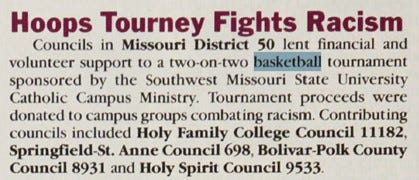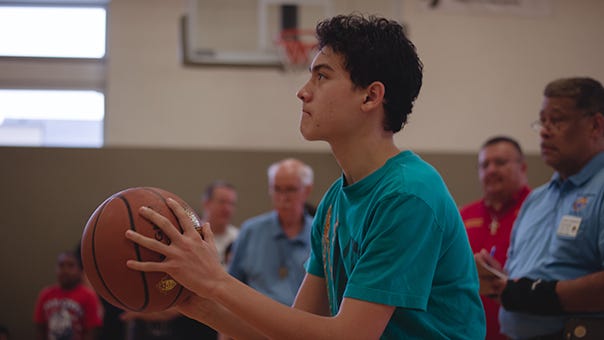A History of the Knights of Columbus and Basketball
An exploration of the Knights of Columbus’ impact on the game of basketball

In the early months of the year, pounding basketballs and swishing nets echo in gymnasiums across the United States — sounds signaling the commencement of the Knights of Columbus Free Throw Championship. It is a nearly 50-year old tradition, providing boys and girls from ages 9 to 14 with an athletic outlet and encouraging the values of sportsmanship and healthy competition.
Since 2017, there have been more than 200,000 participants in these contests. And despite the COVID-19 pandemic beginning in early 2020 in the United States, the free-throw competitions were still held, with several adapting to become virtual events.
But the Knights’ impact on basketball, though small, was significant enough on the game’s growth and status throughout the 20th century — from sponsoring teams and tournaments around the world, providing funds for charitable causes, to even steering the National Basketball Association (NBA).
A Potent Factor in Growing a National Game
Father Michael McGivney, founder of the Knights of Columbus, never played basketball, unlike other sports. He died a year before its creation. But unlike baseball, which has multiple legends and theories of its founding, basketball’s origins are well established in history.
In 1891, James Naismith was tasked to create an indoor game for students at Springfield College during the winter. He developed 13 rules and nailed two peach baskets to the lower rail of the college gymnasium balcony creating the court which hosted the first basketball game. As he stated in Columbia, February 1940, “Basketball was not intended to take the place of football but rather to be an additional game that could be played indoors at night in the winter season.”
The game immediately took off, spreading to colleges and local YMCAs. By 1905, basketball was officially recognized as a permanent winter sport. The same year, the Columbiad — the Knights of Columbus’ magazine prior to Columbia — first mentioned the sport. Council 336’s team from Fort Edward, N.Y., was featured for winning a “large majority of the games in which it has taken part,” winning its final game 26-21 over the “best team in northern New York.”
It was only the beginning. Knights of Columbus councils — much like their efforts with baseball — formed their own teams and leagues throughout the country. They also became affiliated with national sports groups, including the National Catholic Athletic Association and later on the Catholic Youth Organization (C.Y.O.). By 1927, the Knights had more than 1,100 teams across the United States. The organization observed it was a “potent factor in developing a great national game” (Columbia, March 1927), and, in 1939, the Supreme Council formally recognized the sport’s popularity, encouraging councils to promote basketball not only for members, but for Catholic youth.
The game resonated, especially with Catholics in the early 20th century, partly due to its accessibility among the working-class, as The New York Times suggests. Unlike other sports, the overhead costs to basketball were inexpensive. It was also the “most democratic of sports” and the “only really American game,” Eddie Dooley wrote in “Basketball is Growing Up” (Columbia, February 1942). He further stated, “Baseball leans heavily on the pitcher, and football on the quarterback, but basketball calls for an all-out effort by every man on the team.”
Father McGivney founded the Order to assist these working-class demographics in the late 19th century, and it had the resources to do so, even internationally after the First World War. In the 1920s, Knights from Chicago funded a high school basketball team from the Rosebud Indian Reservation in South Dakota to compete in a national tournament when the team was searching for financial help. During World War I and World War II, the Order sent over basketball nets and supplies as part of its effort to provide recreational outlets for the Allied troops. R.F. Nelligan, a captain and the Cantonment Athletic Director observed, “In one week alone thirty-two basketball games were played” at the Knights of Columbus hut in 1918.
Meanwhile, the K of C founded playgrounds in Rome to benefit the Italian youth at the behest of Pope Benedict XV. Though soccer was mostly the sport of choice, basketball did not go unnoticed. In one instance in 1927, more than 2,000 “enthusiasts were cheering their favorites in a championship basketball game,” which was entirely under the sole supervision of the Knights of Columbus. On some occasions, even seminarians could be spotted playing the sport in their cassocks on the K of C courts.
Additionally, the Order assisted in sponsoring basketball tournaments and exhibitions in Asia as well, specifically to the Philippines where the sport quickly caught on. By the 1960s, the Knights of Columbus in the Philippines conducted the “most successful athletic delegation abroad” when it sent a basketball team on a goodwill tour in Japan.
The Association
The NBA was established in 1946, originally as the Basketball Association of America and consisted of 11 teams, including the New York Knickerbockers, Boston Celtics, Toronto Huskies and Washington Capitols. A year later, the Minneapolis Lakers were founded in the competing National Basketball League.
Then, in 1948, the two leagues merged into the NBA. But the NBL-championship Lakers, led by coach John Kundla — a member of the Knight of Columbus — along with star George Mikan did not skip a beat. In the team’s inaugural NBA season, they won the championship over Red Auerbach’s Capitols. The Lakers not only repeated, but won three more times in the span of six years, becoming the league’s first dynasty.

Kundla often worked with his brother Knights in Council 435 and their Youth Activity Committee. On one noted occasion, he brought his Lakers to the local Catholic Boys’ Home to put on “a two-hour workout,” where the kids could play with the stars. He was inducted into the Basketball Hall of Fame in 1995 as well as the College Basketball Hall of Fame in 2006.
But he was not the only Knight to make an impact on the NBA.
In 1967, the NBA owners selected J. Walter Kennedy — mayor of Stamford, Conn., and Knight of Columbus — as the second commissioner of the league. When he assumed the role, the NBA had only nine teams, no TV contracts and a waning audience. There was also the rival American Basketball Association (ABA), which siphoned players with exorbitant contracts. However, Kennedy met the challenges head-on, doubling the amount of teams to 18, landing a TV contract worth $9 million, and increasing attendance from 1.9 million to 7 million by the end of his tenure.
He was also a champion of social causes, particularly Special Olympics. In his retirement, the NBA named an award in his honor — the J. Walter Kennedy Citizenship Award — given to players, coaches or staff who show “outstanding service and dedication to the community.”
A Tool of Evangelization
Throughout the 20th century, Knights sponsored basketball leagues — including the famous Knights of Columbus Invitational Scholastic Basketball Tournament in Washington, D.C. — as a way to not only help provide friendly competition for the youth, but to contribute to charitable causes.
The Washington, D.C., tournament’s proceeds often went to the education of children with special needs; a tournament in South Dakota supported the St. Paul Mission School, which helped Native American children on the Yankton Sioux Reservation; another tournament raised funds for a Benedictine student mission trip to assist an orphanage in Mexico; Louisiana Knights sponsored a wheelchair basketball league; Kansas Knights held basketball games to raise funds to support seminarians in the Diocese of Wichita; and Missouri councils sponsored tournaments whose proceeds went to college campus groups “combating racism.”
The causes Knights supported were wide and praised by many, including several presidents such as Jimmy Carter and Ronald Reagan. Even Pope John Paul II recognized the service of the Knights in basketball by blessing the Ontario-based Kingston Knights of Columbus Basketball League on its 40th anniversary in 1995.
Past Supreme Knight Virgil Dechant stressed the importance of Knights’ involvement with sports, once saying, “One only need look at the baseball and football fields, the basketball courts, the hockey rinks and other athletic facilities, to see the K of C councils are there in the forefront, sponsoring teams, coaching and lending support to our young stars of today, the leaders of tomorrow.”
To support the “young stars of today,” the Knights of Columbus began the Free Throw Championship in the early 1970s to give “boys and girls who may not be team-oriented a chance to excel on their own.”
Within the first few years, thousands of councils held free-throw competitions and hundreds of thousands of boys and girls participated. In the mid-1990s, councils even collaborated with NBA teams, such as the Toronto Raptors and the former Washington Bullets. Meanwhile, Knights continued to sponsor teams, leagues and even clinics around the world, including one with Philippines Basketball Association (PBA) star Ramon Fernandez.
But basketball was and continues to be a tool of evangelization for the Knights. Father George Willmann, known as the “Father McGivney of the Philippines,” created basketball leagues to keep children in need off the streets during the 1930s and 40s. One priest, Joseph Moreno, would often play at the local Knights of Columbus hall. As he told Columbia in 1987, “Every time I went down to the K of C to play basketball, they had a different vocations poster up. I used to think the K of C had a hex on me.” But this eventually turned into Moreno finding his calling to the priesthood.
For Hennessy Council 6145 in Newtown, Pa., their basketball tournaments “attracted the fathers of players to consider membership in the Knights,” according to Columbia July 1986. And in 2019, basketball tournaments in Puerto Rico not only funded a costly surgery for a 17-year-old teenager, but were also an avenue to evangelize, bringing teens back into the Church.
The Final Buzzer
There is a common idiom among basketball players that “Ball is Life.” And maybe, for some people, it can be. But to what extent is a different issue. For the Knights of Columbus, it was a game to help the working-class and underprivileged, with a missionary spirit similar to its founder, Blessed Michael McGivney.
Basketball is a tool for evangelizing; it is a tool to support the community; it is a tool to help vocations; and it is a tool to help young people grow — by teaching children sportsmanship and the true value of respect and fairness.
That is why, after nearly 50 years, the Free Throw Competitions continue on. And who knows, maybe the next basketball star could step up to the free-throw line.
To learn about the program, click here.



